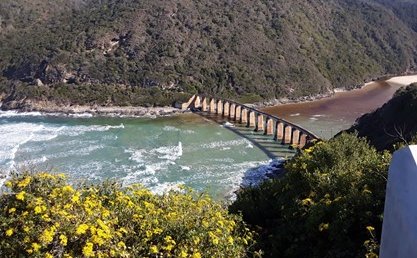A Tale of Engineering Marvel: The Kaaimans Bridge

In the late 19th century, the notion of connecting the towns of George and Knysna in South Africa via a railway line began to take shape. It wasn't until the 1920s, however, that this vision started to materialize. Led by the ingenuity of NK Prettejohn, an engineer renowned for his prowess in railway construction, the ambitious project embarked on a journey of its own.
The construction of the railway line and its centerpiece, the Kaaimans Bridge, was no small feat. It required thirty years of meticulous planning and preparation before ground was finally broken in 1925. One of the early challenges was the need for a temporary bridge over the Kaaimans River, which was ingeniously crafted using very long blue gum logs transported from Witfontein, northwest of George. These logs, too long for conventional transportation, were creatively fastened onto wagons, overcoming the logistical hurdle.
The Kaaimans Bridge itself was a marvel of engineering, combining bridge-building and tunneling techniques. Caissons were employed, sunk 23 meters below the riverbed, with eight-meter pylons rising above. The project faced numerous obstacles, from challenging terrain to severe weather and labor issues. However, the dedication and perseverance of the engineers prevailed, and on 30th November 1928, the 210-meter-long bridge welcomed its first scheduled train crossing.
The completion of the bridge marked a significant milestone for the Southern Cape coast, fostering vital transportation links between George and Knysna. It facilitated the movement of resources from the Knysna forests, enhancing trade and connectivity between the coastal towns and the interior. Moreover, it revolutionized passenger travel, offering a scenic journey between George and Knysna, which later became popularized as the Outeniqua Choo Tjoe tourist train route.
Over the years, the iconic Kaaimans Bridge and the railway line garnered international recognition, attracting tourists from far and wide. Railway tourism flourished, becoming a cornerstone of the economies of George and Knysna, while supporting local businesses along the route. By 2002, the route was carrying an impressive 115,000 passengers annually, with a significant portion being foreign tourists captivated by the allure of steam-powered locomotives traversing the picturesque landscapes.
In recognition of its historical and engineering significance, Transnet declared the bridge a preserved railway in 1992, later handing it over to the Transnet Foundation Heritage Preservation in 1993. The South African Institution of Civil Engineering honored the bridge in 2019, declaring it the "National Historic Civil Engineering Landmark of the Year," highlighting its enduring legacy and the crucial role of infrastructure in shaping our daily lives.
As we marvel at the Kaaimans Bridge and its storied past, we are reminded of the transformative power of human ingenuity and perseverance in overcoming the most daunting of challenges, leaving an indelible mark on the landscape and the hearts of those who traverse it.




Share This Post